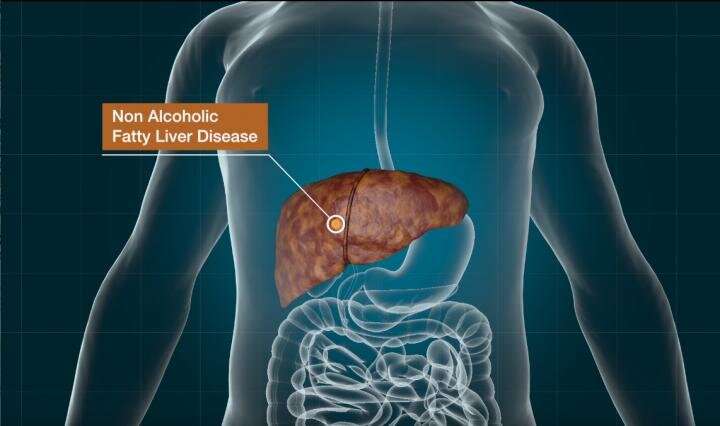Nonalcoholic fatty liver disease (NAFLD) often leads to various liver complications, but there is a lack of drugs for the treatment of NAFLD. Credit: Gwangju Institute of Science and Technology
Nonalcoholic fatty liver disease (NAFLD) is a condition characterized by excessive fat accumulation in the liver. It can cause serious complications, including nonalcoholic steatohepatitis, cirrhosis and cancer. Although prevalent, there is a dearth of drugs to treat NAFLD, with current therapies revolving around lifestyle interventions.
In a recent study published in Journal of Medicinal Chemistry, scientists from Gwangju Institute of Science and Technology, Korea, led by Prof Jin Hee Ahn, aimed to find new therapeutic options for NAFLD. Prof Ahn says, "NAFLD is a serious public health problem worldwide. However, no pharmacological agents have been specifically approved for its treatment yet."
For their study, the scientists focused on a well-known neurotransmitter called serotonin. Serotonin is widely known as the "happy" neurotransmitter, and its deficiency in the central nervous system (CNS) can cause various brain disorders. But, not many know that it is also found in the gastrointestinal tract; here, it is called "peripheral" serotonin, which has different functions altogether, such as regulating lipid metabolism in the liver.
In a previous study published in Nature Communications, Prof Hail Kim, the co-corresponding author of this study, had investigated peripheral serotonin as a drug target with knockout mice models (mice lacking functional peripheral serotonin). This study reported that these mice showed reduction in liver weight, hepatic lipid accumulation, and hepatic triglyceride content and improved NAFLD activity.
These findings formed the basis of Prof Ahn's study and prompted the research group to identify new peripheral serotonin antagonists. The scientists selected a CNS drug approved for the treatment of Parkinson's, called pimavanserin. Pimavanserin acts as an "antagonist" to serotonin, mimicking its effect in the CNS. The scientists then structurally modified this drug such that it cannot permeate the blood-brain barrier by adding different types of molecules to it. In this way, they generated an array of novel compounds. On testing these, the scientists found that one promising compound in particular showed very low blood-brain barrier permeation, and thus had the potential to target peripheral serotonin systems.
The scientists tested this compound in obese mice with impaired liver function. Interestingly, the mice showed improvement in symptoms of fatty liver disease, such as improved glucose tolerance. Additionally, their body fat decreased while lean body mass increased. Prof Ahn says, "Through the chemical optimization of an existing drug, pimavanserin, we identified a new peripheral agent for the possible treatment of NAFLD."
Although this novel compound is yet to be tested in humans, these findings show that it has remarkable potential in treating fatty liver disease. Optimistic about these findings, Prof Ahn concludes, "We hope that our novel drug candidate will offer relief to patients bearing the brunt of NAFLD."
More information: Minhee Kim et al, Design, Synthesis, and Biological Evaluation of New Peripheral 5HT2A Antagonists for Nonalcoholic Fatty Liver Disease, Journal of Medicinal Chemistry (2020). DOI: 10.1021/acs.jmedchem.0c00002
Journal information: Journal of Medicinal Chemistry , Nature Communications
Provided by GIST(Gwangju Institute of Science and Technology)





















